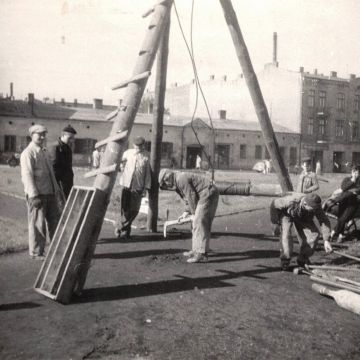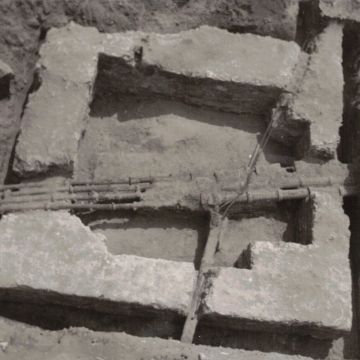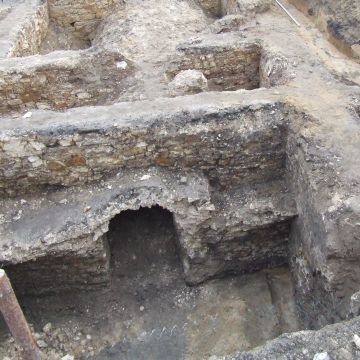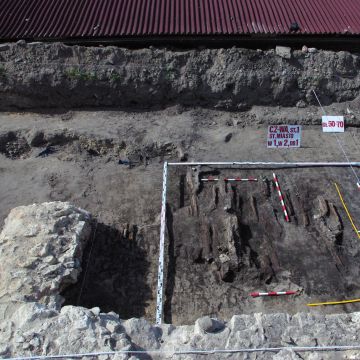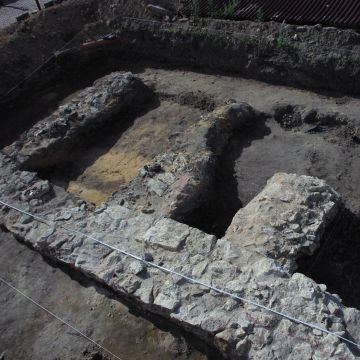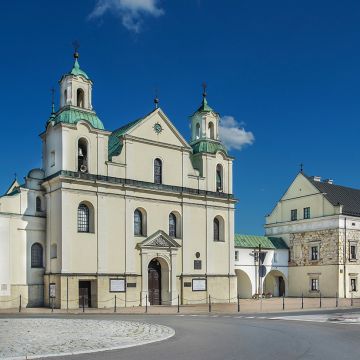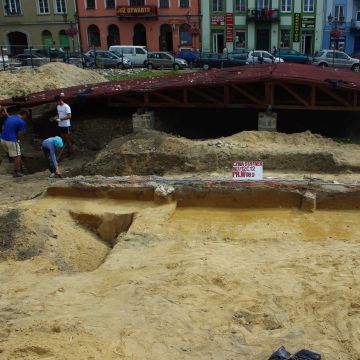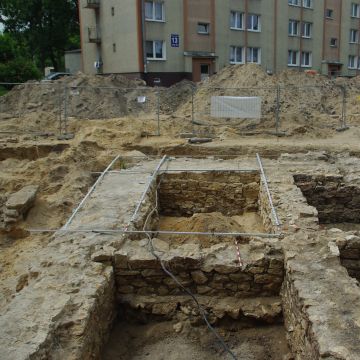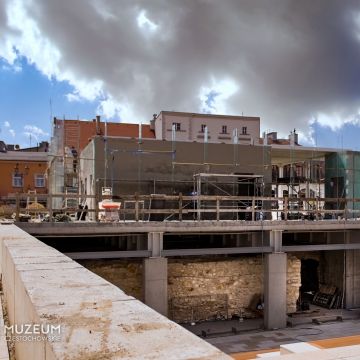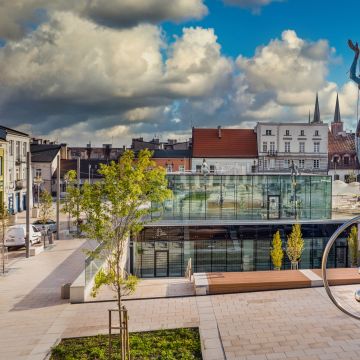History of archeological studies in the Old Town
1960
In 1960, 24 archeological and geological exploratory drillings were made, with a total length of 87 m. They covered the area between Bohaterów Getta Street in the north and the square in front of the cathedral in the south, and from Daszyńskiego Square in the west to the Warta riverbank in the east. The results of these studies led to the conclusion that the area known as the Old Town was not settled until the Middle Ages. The study was led by Włodzimierz Błaszczyk, archeologist and the director of the Regional Museum in Częstochowa at that time.
1968
In 1968, the first archeological exploration of the Old Town was conducted. Archeological objects and architectural relics were encountered during the construction of a heating pipeline. An area of 3360 m2 was explored. Significant amounts of human bones and fragments of limestone buildings were found near the northwest corner of St. Sigismund's Church. According to Włodzimierz Błaszczyk, the research director, the survey located the western line of the town walls and a presumed tower, built on a roughly square plan. North of it, foundations of a building with walls incorporated into the walls of a residential building were uncovered, which made it possible to demarcate the western, northern and southern walls of the original 16th-century building, incorporated into the system of town walls. By the tower on the south side and by the building on the north side, the foundations of the town's peripheral walls connected with both structures were thought to be located. During the heating pipeline construction, fragments of the cellars of buildings on the southern frontage of the Old Market Square were found. The area of the church cemetery was also traced, where mass graves of about 1000 people dating back to the 15th–17th centuries were discovered. Blaszczyk's report also mentions the discovered relics of the cemetery chapel and the bell tower. Significant amounts of historic materials were acquired.
1992
In 1992, an observation of the Old Market Square in Częstochowa was made with the SIR-8 radar. Through wave data interpretation, the locations of cultural relics were determined and the location of potential historical buildings was revealed to be in the northern and southeastern parts of the preserved Old Market Square.
1996
In 1996, archeological sampling surveys were conducted in the Old Market Square. No architectural relics were found in the excavations, only leveling backfill layers and a layer of burned remains were registered. Further investigations revealed that the placement of the excavations was unfortunate for archeologists, as they were located in-between archeological sites. The research was directed by Iwona Młodkowska-Przepiórowska.
2006
In 2006, a cave-in began to appear in the Market Square. In its southeastern corner, at a depth of about 150 cm, an opening was observed, exposing the ceiling of a cellar chamber. A preliminary survey of the room was undertaken, and as later research indicated, it was the City Hall cellars. This marked the beginning of several seasons of archeological excavations led by Iwona Młodkowska-Przepiórowska in the years 2007–2012.
2007
In 2007, archeological excavations began in the Market Square, with the scope of work aimed at gathering information about the City Hall building. Foundation walls were partially exposed, mainly from the southern and eastern side. The western cellar was cleared of rubble. Inside, considerable amounts of ceramic pottery fragments dating back to the 16th–18th centuries, stove tiles, iron and glass items, as well as animal bones were found.
2008
In 2008, excavations continued in the Market Square. They aimed to fully capture the layout of the peripheral walls and to determine the architectural structures of the inner cellars of the City Hall.
2009
In 2009, exploration was carried out to the north and west of the 2008 excavations. They led to the discovery of a number of further objects, which were part of the development of the market square area. Uncovered to the north of the cellars were shallow foundations of a building, probably with a wooden structure, a stone well, and a single-chambered building on a solid stone foundation – presumably serving as a cold store. In the vicinity of the well and cold store, fragments of limestone paving were also discovered.
2011
In the years 2011–2012, excavations were conducted in the St. Sigismund's Church and Monastery Complex in connection with the implementation of the program entitled "Revitalization of the St. Sigismund's Parish Monastery Complex". Nine archeological sites were discovered and surveyed, including the remains of a moat, two destroyed cinerary graves from the Lusatian culture, a kiln used for making devotional items (?), and 1,093 graves from the parish cemetery. Medallions, small devotional paintings on copper plates, small crucifixes, coins, buckles, buttons, and rings, among other things, were found with the remains of the deceased. These items are displayed in the exhibition in the Old City Hall – the building of Częstochowa Museum. The surveys were conducted under the guidance of Roland Marek and Jacek Wojcieszek.
2012
In 2012, a further area to the west of the brick structure was surveyed. The area subjected to archeological research was very damaged by burrows filled with building rubble and anthropogenic waste from different periods, as well as pits related to the construction of power and water supply lines. In the western part, relics of stalls, a smithy and a wooden well were discovered.
2015
In 2015, while providing archeological supervision for the renovation of Nadrzeczna Street and Bohaterów Getta Square, the foundations of Church of St. Barbara were discovered. Relics of the church were excavated – foundations of lime stone cemented with lime-sand mortar and 185 graves from the church cemetery, as well as the remains of presumably a chapel, of which only foundations of lime stone cemented with clay were preserved. During cemetery surveys, a treasure trove of silver coins from the 17th century was found under a coffin. The study was conducted under the leadership of Iwona Młodkowska-Przepiórowska.
2019
In the years 2019–2021, construction works were carried out in the Old Market Square as part of the project entitled "Reconstruction and extension of the Old Częstochowa City Hall building along with land development" co-financed with European funds, implemented as part of the Regional Operational Program of the Silesian Voivodeship for 2014–2020. Apart from the modernization of the Old Market Square, the project included the creation of a pavilion, which in the underground part would house a branch of the Częstochowa Museum, and in the overground part – a cafe. The steps leading up to the museum serve as a sort of amphitheater for small special events. There is an outdoor gallery of sculptures by Jerzy Kędziora and a leisure zone with street furniture and a fountain.
An archeological survey was carried out during the project implementation. South of the City Hall cellars, in an area not yet explored, foundations of another facility (probably originally wooden structure on a stone foundation) were discovered, attached to the City Hall building. On the southern side, relics of two more wooden wells were also uncovered.
2021
On August 18, 2021, the newly constructed Old City Hall facility was opened to the public. It presents relics of the cellars of the first Częstochowa City Hall, which was erected in the 16th century and used until the beginning of the 19th century. They are accompanied by a long-term archeological and historical exhibition entitled History of Częstochowa – a City by the Warta River. Maciej Kosiński and Magdalena Wieczorek-Szmal, workers of the Archeology Department of the Częstochowa Museum, are curators of the exhibition.

